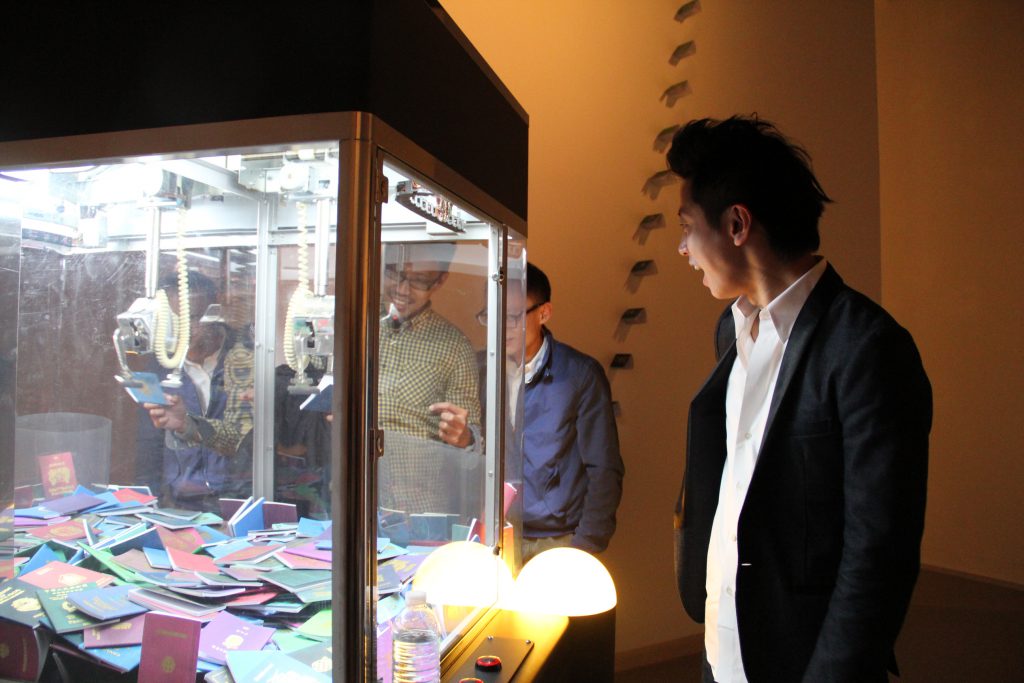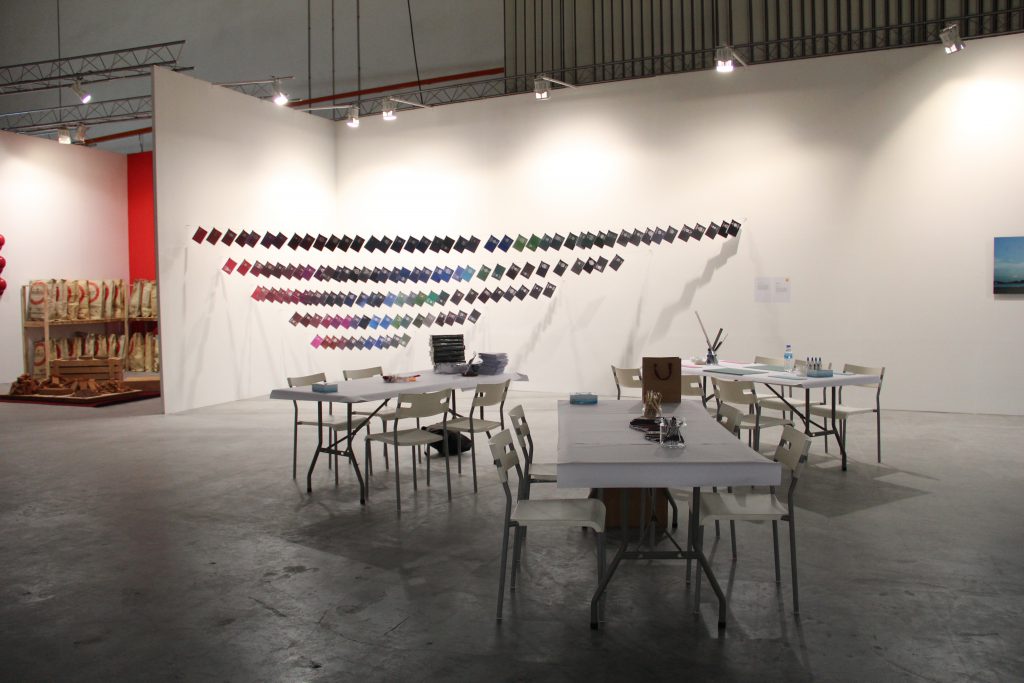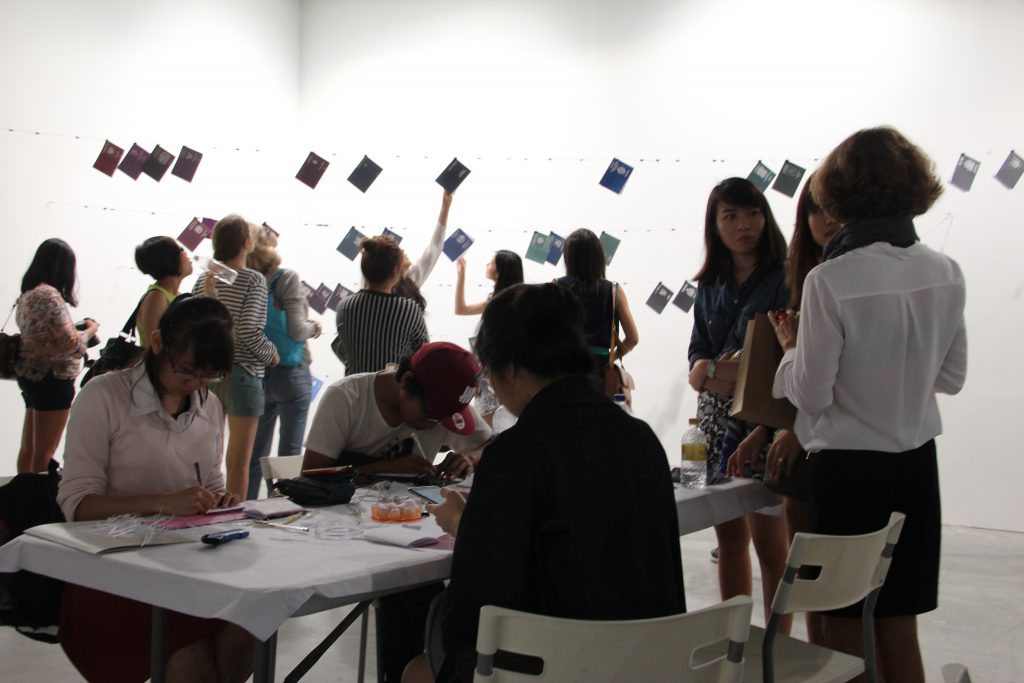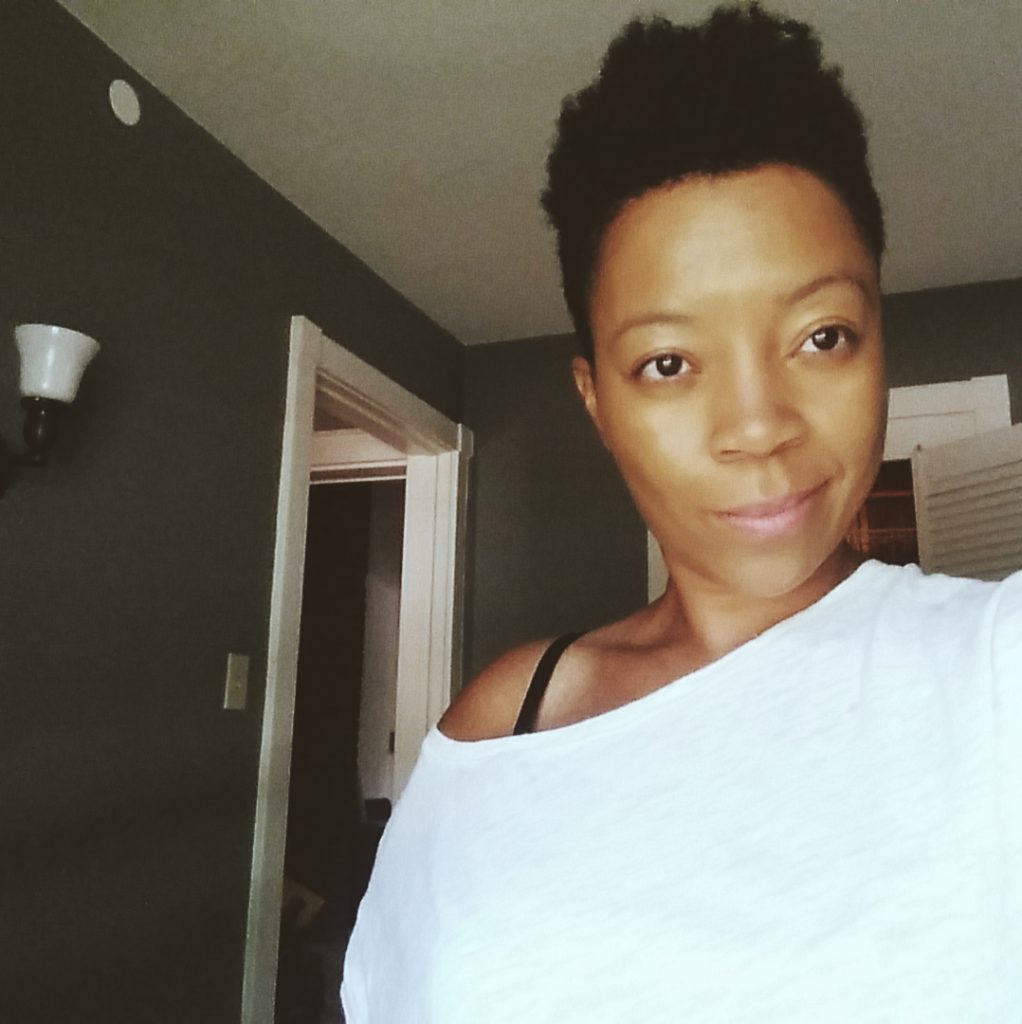This interview is part of a series of conversations exploring the practice of artists featured in Connect – Hyde Park Art Festival, a free three-day arts festival spanning the intersection of visual + performing art, designed objects, film, music, fashion and literary culture. Conceived by Eric Williams (The Silver Room) in collaboration with the University of Chicago, CONNECT joins the heart of Hyde Park with the pulse of Chicago’s existing arts community.
This edition in the series features Indonesian artist Tintin Wulia, a current artist in residence at the Hyde Park Art Center who creates interactive works that question international citizenship, global migration, and the power dynamics of passports.
Tempestt Hazel: Through your residency at the Hyde Park Art Center you’ve had the opportunity to spend time in Hyde Park and Chicago. Now that you’ve been here for a while, what are your thoughts of the city?
Tintin Wulia: My experience with people is wonderful. But my experience with transport for people between Hyde Park and downtown Chicago is another thing. Having lived in places where transport for public is comparably a given, and places where the concept of transport for public is quite different, experiencing problems with transport between Hyde Park and downtown Chicago sparks a lot of thoughts. Amongst these thoughts is what this fact says about inclusion and exclusion, value systems, and also about how trust works in a society. These are quite complex; I think it deserves a long discussion.

TH: What inspired you to create the installation and workshop-performance “Make Your Own Passport”?
TW: In 2007, I imagined it would be amazing to be able to see passports from all the different countries on earth next to each other. Through seeing this, we would be able to see how diverse the world is, but most importantly, we’ll be able to see how all these countries are actually part of a system, an organism. So that year, I began collecting and making passports for an ongoing project, “(Re)Collection of Togetherness”, showing them as installation, in stages.
While that project continued, I made a few more interactive passport works, like “Lure” (2009) in which people can win a random passport from a claw/skill-tester machine – only if they’re lucky or skilful. I also use all the passports I’ve made as props in other works, such as “How I Captured Those Wantons” (2010), which is a close-up magic performance. I realised it’s even more amazing if people could touch these passports – and make them theirs. So in “Make Your Own Passport” (2014), I let people make the passports themselves.

TH: You’ve recreated this in Detroit, Michigan and Winsor, Ontario. How does the conversation change depending on the city you’re working in?
TW: The most recent iteration of “Make Your Own Passport” was at the UN Conference Habitat III in Quito, Ecuador, as part of Next City’s World Stage. After Detroit, MI and Windsor, ON, it has also been performed in Singapore and Yogyakarta, Indonesia.
In each city there were always a range of emotional reactions, as well as a lot of learning and exchange of stories. In Detroit somehow people started talking about their family’s ancestral origins. In Windsor, a guy barged into our stall madly, accusing me of smuggling illegal migrants. In Singapore, a participant recounted a story about a stateless person in her family after listening to my story about a friend of mine who was stateless for the first 17 years of her life. In Yogyakarta, a participant who’s gotten a stateless status lingered and tried to negotiate with other participants so that she could get a passport – and someone actually responded positively, swapping place with her. A few weeks ago in Quito, for the first time a participant who got a USA passport wasn’t too happy with it – she lives in a very peaceful place at the Middle of the World (Mitad del Mundo), she said, and she doesn’t want to be American. Also in Quito I learned about what they call Coyotes for the first time, from a construction worker who almost lost his life because of them.

TH: The people who take you up on your offer to make a passport choose one of 142 countries at random rather than choosing a country for themselves. Why did you decide to approach it this way and has this method revealed anything surprising in the process?
TW: I want “Make Your Own Passport” to be a place where you can contemplate the citizenship you have and imagine what it’s like if you had a different citizenship. Most of us can’t choose where we’re born and which parents were born of. And most of the time, because of the way citizenship works, these things that you can’t choose often become the most decisive factor of your life. Only a small number of privileged people in the world might be able to choose a citizenship later on in their lives without too much effort.
When people see the colourful passports in “Make Your Own Passport”, they usually get too excited and mostly wouldn’t expect that they can’t choose their passport. Many contemplates what it means to get a different citizenship while they’re making their randomly-drawn passport. So far, there were quite a lot of shocks, but only little surprises.
TH: What is inside of the passports people create?
TW: Physically, just blank pages. But the time that we take to make the passport is in it too. I hope this means that all the memories of making it, and all the thoughts and emotions, and stories exchanged during the process, are kept within the passport as well. This is why I also ask people to write their reflections.
TH: Although these passports aren’t official, using them at a central object in this performance speaks to many different things. For instance, passports can read as symbols of freedom and as access to the world. Or they can been seen as a symbol of identity and citizenship. Then, in some cases, a lack of a passport can mean limitation and immobility. In what ways do you hope they operate within this piece and your work in general?
TW: Yes, in many cases, a lack of passport can mean limitation and immobility. We also must remember that however dear one’s passport is to them, it actually belongs to the government and can be taken away anytime. At a border, or in other daily situations involving borders, the passport you hold can decide what happens to your life – it’s not only a symbol. Also, it’s not only the lack of passport that limits mobility. Having an underprivileged passport, like an Afghani passport, can limit your mobility a great deal. It is interesting to see this and think of the Universal Declaration of Human Rights which says “All human beings are born free and equal in dignity and rights”, for example. Isn’t it funny to think that the simple, mostly unconscious act of being born – in a certain place, of certain parents – turns out to be the most decisive act in your whole life?
Make Your Own Passport is a reminder of these facts and many others, but more than that, also with my work in general, I hope to continue creating spaces where we all can continue talking, thinking, and doing something about how we can live together.

TH: Finally, you wear the title “The Most International Artist In The Universe.” Why is global citizenship important to you? And what stamp do you not have in your passport that you hope to get one day?
TW: The most legendary stamp I’ve ever gotten in my passport was a refusal-of-entry stamp. I’ve got one in Frankfurt in 2011, ironically on my way to do a performance on borders. It marked the beginning of a period of being stopped at different borders. It was a horrible, but very valuable. I learned a lot from it. As an Indonesian passport holder, crossing national borders is never easy. I can’t hope to have just any stamp – so I just hope I won’t get a refusal-of-entry stamp again.
“The Most International Artist in the Universe” is intended to be ironic – it’s the title of a video work I did in 2011. In the video, I go through the possibilities of being born at exactly the same place on earth, but in a different time. There’s hope as well, though, in that ironic title – the universe is limitless, and so hopefully the concept of “nations” is only limited to humans.
“International,” for me, is different from “global.” That prefix, “inter-“ should make us see the world as it is. No nation can exist without the others. No national can exist without other nationals. You can’t just ignore borders. They won’t just go away if you ignore them. “Global” is a wish, but it often tends to be an escape. The term “global” omits some of the most important realities of the world. Borders still exist – in fact, they’re getting stronger every day. The fact that some people will be able to leave to Mars soon will only make our notions of borders more complex. We can’t keep dreaming.
To learn more about Tintin Wulia’s work, visit her website.
Featured Image: Make Your Own Passport Installation and workshop-performance at Next City’s World Stage, Habitat III, 2014. Image courtesy of the artist.
 Tempestt Hazel is a curator, writer, artist advocate, and founding editor of Sixty Inches From Center. Her writing has been published in the Support Networks: Chicago Social Practice History Series, Contact Sheet: Light Work Annual, Unfurling: Explorations In Art, Activism and Archiving, on Artslant, as well as various monographs of artists and exhibition catalogues. tempestthazel.com
Tempestt Hazel is a curator, writer, artist advocate, and founding editor of Sixty Inches From Center. Her writing has been published in the Support Networks: Chicago Social Practice History Series, Contact Sheet: Light Work Annual, Unfurling: Explorations In Art, Activism and Archiving, on Artslant, as well as various monographs of artists and exhibition catalogues. tempestthazel.com






